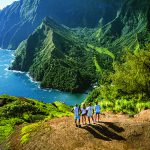
Why not Greenland? I took a seven-day expedition on Silver Explorer, and it was phenominal.
This is the perfect trip to couple with a longer Baltic itinerary roundtrip Copenhagen. That’s because flying from the Danish capital is the easiest way to get to and from Greenland. It always struck me as a bit odd that from the United States, we had to fly over Greenland, land in Denmark, then get on a plane to retrace our route back to Greenland. But that’s the way it is in this remote region of the world.
The Silversea expedition marks my third trip to Greenland, and I hope it’s not my last. Anything but green (80 percent of Greenland is covered in ice), the world’s largest island is part of the North American continent, but it is connected to Europe, an autonomous country within the Kingdom of Denmark. Greenland is a fascinating place and there’s no better way to experience it than on a Silversea expedition.
Here’s what the Silversea voyage included:
- Cruise into deep fjords with active glaciers and spectacular icebergs
- Meet Greenland’s native Inuit
- Discover the cultures of remote Greenlandic towns
- Visit the world’s fastest moving glacier
- See the site where the famous Qilakitsoq mummies were found

There was also plenty of time spent in Zodiacs, beginning in Kangerlussuaq with the transfer from the pier to Silver Explorer, waiting at anchor for us. In fact, the expedition begins and ends in Kangerlussuaq, Greenland’s connection with the outside world. The Kangerlussuaq airport dates from American settlement during and after World War II, when the site was known as Bluie West-8 and Sondrestrom Air Base.
We headed just north of the Arctic Circle to Sisimiut, the second-largest – as well as the northernmost – town in Greenland where the port remains free of ice in the winter. Sisimiut also has the peculiar distinction of being the southernmost town where there is enough snow and ice to drive a dogsled in winter and spring.
In Sisimiut, traveling by sled has been the primary means of winter transportation for centuries. The Greenlandic sled dog has been bred to rank among the world’s strongest working dogs.

Another typical and iconic “vehicle” of transportation is the qajaq (known to us as the “kayak”) and although most Greenlandic hunters or fishermen use modern boats, many still have a qajaq.
Sisimiut has been home to humans for almost 4,500 years. Ruins of early settlements can still be seen west of the town. The Sisimiut Museum houses part of its collection in Greenland’s oldest surviving church as well as in a peat house.

After Sisimiut, it’s on to Qeqertarsuaq Island, the “Big Island,” where we visited the village with the same name at the southern tip of the island during a guided walk through this small fishing and hunting town of 1,000 inhabitants.
Day four took us to Qilakitsoq and Uummannaq. In Qilakitsoq, we set off to unearth history’s mysteries as we visit the gravesite of 500-year-old mummies, the best-preserved human remains in all of North America. Commonly referred to as the “Greenland Mummies,” eight mummies (six women and two children) were discovered in 1972 and are believed to date back to 1475 A.D. The mummies are now in the National Museum in Nuuk.
Near the landing site are the remains of early settlements. The houses, food caches, graves belonging to the Thule culture seem to have been abandoned more than 200 years ago.
Before departing Disko Bay we enjoyed a Zodiac tour of the rugged coastline and the many icebergs that get stranded here after breaking off from the Jakobshavn Glacier.

During the afternoon we cruised past Arve Prinsens Island to reach one of the glaciers north of Ilulissat. This is where Paul-Emile Victor started in 1948 to reach the icecap. The glacial front still has a length of almost 3 miles and calves several times a day.

On day six we visited Ilulissat. The town is known for its long periods of calm and settled weather, but the climate is a bit colder due to its proximity to the fjord. During our guided walking tour of Ilulissat, we visit the local history museum, which used to be the home of famous arctic explorer Knud Rasmussen and enjoyed a demonstration of ancient fishing methods.
Just after sunrise, I was out on deck to see the northern hemisphere’s most active glacier – the Jakobshavn Glacier. Known as the birthplace of icebergs, the Ilulissat Icefjord produces several million tons of ice each day. Its entrance is often surrounded by icebergs in all shapes and sizes and in varying shades of white and turquoise.
I’ve been on four Silversea expeditions during the past several years and all have exceeded my expectations. They all have been life-enriching experiences, among the best cruises that I’ve ever done.

If I were considering this trip again, I’d seriously take a look at doing a Baltic cruise, disembarking, flying to Greenland, then returning to Copenhagen before flying home.
You’ll need to check with your favorite Cruise Specialists’ travel counselor to see if there is space remaining on a Silversea Expedition to Greenland. No need to worry about packing winter gear for Greenland: Silversea gives you a complimentary Silversea-branded parka that will keep you warm out among the icebergs, and there will be plenty of those.
View Silversea Expedition Cruises




